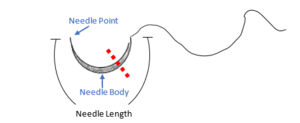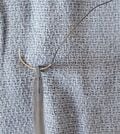
Needle point awareness[edit | edit source]
An important concept when suturing is needle point awareness. This means that you should know the needle length and curve of your suture needle so well that you can visualize it traveling within the tissue. To achieve needle point awareness, you must load (attach your needle to your needle driver) at the 2/3rd point along the needle body.
-
Demonstrates the appropriate location to place the needle driver along the needle body
-
The suture needle should be angled approximately 30 degrees forward when loaded appropriately.
Suturing Techniques[edit | edit source]
Simple Interrupted Suture[edit | edit source]
You will use this technique when you suture the abdominal wall layers in place and when you are closing the surgical wound on the skin in an open appendectomy.
- Load your needle to achieve needle point awareness and ensure it is angled slightly forward
- In your non-dominant hand with forceps, elevate the tissue on the side of the wound closest to you
- In your dominant hand hold the needle driver and pronate your dominant wrist until the needle is perpendicular to the tissue you want to suture
- Drive the needle through the tissue by supinating your wrist
- Release the needle from the needle driver and reload it on the other side of the needle
- Continue to supinate your wrist to pull the needle through the tissue
- After ensuring your needle is loaded appropriate, repeat steps 2 – 6 for the other side of the wound
- Instrument tie the suture with the appropriate number of ties for suture material
- The goal is to bring the edges of your wound together without too much tension
- Cut the tails of the suture
- Ensure the tails are not too short such that they may unravel
Horizontal Interrupted Suture[edit | edit source]
You will use this technique when you suture the abdominal wall layers in place and when you are closing the surgical wound on the skin in an open appendectomy
- Load your needle to achieve needle point awareness and ensure it is angled slightly forward
- In your non-dominant hand with forceps, elevate the tissue on the side of the wound closest to you
- In your dominant hand hold the needle driver and pronate your dominant wrist until the needle is perpendicular to the tissue you want to suture
- Drive the needle through the tissue by supinating your wrist
- Release the needle from the needle driver and reload it on the other side of the needle
- Continue to supinate your wrist to pull the needle through the tissue
- After ensuring your needle is loaded appropriate, repeat steps 2 – 6 for the other side of the wound
- Now, you will complete the same steps but start on the side of the wound that is opposite to you and repeat steps 2-6 two more times
- Instrument tie the suture with the appropriate number of ties for suture material
- The goal is to bring the edges of your wound together without too much tension
- Cut the tails of the suture
- Ensure the tails are not too short such that they may unravel


